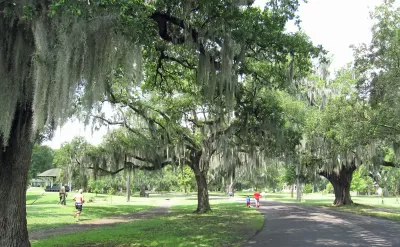Some good news from a state that has seen far too much bad news this year: local officials report that the trees of New Orleans are making a surprisingly strong comeback after devastation wrought by Hurricane Katrina.

"An estimated 320 million trees are thought to have been damaged or killed in Mississippi and Louisiana after Katrina — an unprecedented loss that local researchers in 2007 estimated would change the area’s ecosystem for the worse for generations to come," according to an article by Della Hasselle. "Fast-forward to 2016, however, and officials with New Orleans’ numerous organizations dedicated to protecting green spaces are celebrating what they call an unanticipated comeback for the city’s trees."
City organizations and nonprofit groups have been working hard for more than a decade to restore the city and region's green spaces. According to Hasselle, "the latest tallies show about half of the trees lost to Katrina have been replanted in public spaces alone..." And although a "grand total is difficult to calculate…the number of newly planted trees is even higher" because of the many trees planted on private property, like the yards of residents.
The article details the hard work of the city's Department of Parks and Parkways and organizations like Parkway Partners and the nonprofit NOLA Tree Project in overcoming the many environmental and biological threats that ravaged the region's trees and other plant life after Hurricane Katrina.
Planetizen covered the terrible effects of Hurricane Katrina on the city of New Orlean's greenery in 2007, as well some of the resurgence of the city's parks and open spaces in 2014.
FULL STORY: New Orleans green spaces experiencing unanticipated post-Katrina comeback

Alabama: Trump Terminates Settlements for Black Communities Harmed By Raw Sewage
Trump deemed the landmark civil rights agreement “illegal DEI and environmental justice policy.”

Planetizen Federal Action Tracker
A weekly monitor of how Trump’s orders and actions are impacting planners and planning in America.

Why Should We Subsidize Public Transportation?
Many public transit agencies face financial stress due to rising costs, declining fare revenue, and declining subsidies. Transit advocates must provide a strong business case for increasing public transit funding.

Understanding Road Diets
An explainer from Momentum highlights the advantages of reducing vehicle lanes in favor of more bike, transit, and pedestrian infrastructure.

New California Law Regulates Warehouse Pollution
A new law tightens building and emissions regulations for large distribution warehouses to mitigate air pollution and traffic in surrounding communities.

Phoenix Announces Opening Date for Light Rail Extension
The South Central extension will connect South Phoenix to downtown and other major hubs starting on June 7.
Urban Design for Planners 1: Software Tools
This six-course series explores essential urban design concepts using open source software and equips planners with the tools they need to participate fully in the urban design process.
Planning for Universal Design
Learn the tools for implementing Universal Design in planning regulations.
Caltrans
Smith Gee Studio
Institute for Housing and Urban Development Studies (IHS)
City of Grandview
Harvard GSD Executive Education
Toledo-Lucas County Plan Commissions
Salt Lake City
NYU Wagner Graduate School of Public Service



























